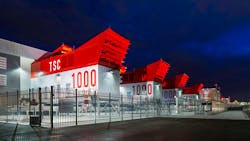How 2024, the Year That Re-Energized Nuclear Power, Foretells Ongoing 'New Nuclear' Developments for Data Centers in 2025
In a world increasingly focused on advanced nuclear technologies and their integration with energy-intensive sectors like data centers, nuclear power could change the way that the world gets its electricity and finally take its place as a clean, renewable, source of power. Evidence of this shift toward nuclear energy and data centers' role in it came in abundance last year, as the U.S. nuclear energy sector was observed undergoing a sea change with regard to the data center industry.
We saw Microsoft, Constellation, AWS, Talen, and Meta with major data center nuclear energy announcements in the Second Half of 2024. With the surge in nuclear stakes has also come a wave of landmark PPAs representing the "new nuclear" industry’s ascendance. To wit, in the latter half of 2024, the data center industry witnessed significant developments concerning "new nuclear" energy integration, specifically in the area of plans for forthcoming nuclear small modular reactor (SMR) deployments by cloud hyperscalers.
Some of the most notable announcements included:
- Amazon's Investment in Nuclear Small Modular Reactors (SMRs): October 2024 saw Amazon reveal partnerships with Dominion Energy and X-energy to develop and deploy 5 gigawatts (GW) of nuclear energy, in a bid for future powering of its data centers with carbon-free energy.
- Google's SMR Pact with Kairos Power: Also in October 2024, Google announced plans to collaborate with Kairos Power to build up to seven SMRs, providing up to 500 megawatts of power. The first unit is expected to come online by 2030, with the entire project slated for completion by 2035.
- Oracle's Gigawatt-Scale SMR Plans: In September 2024, Oracle announced plans to construct a gigawatt-scale data center powered by three small modular reactors (SMRs). Company Founder and CTO Larry Ellison revealed that building permits for these reactors have been secured, and that the project was currently in its design phase. The company said the initiative aims to meet the escalating energy demands of AI and cloud services while advancing Oracle's sustainability objectives.
The surge in such data center "new nuclear" agreements has also been exemplified by recent major announcements from key "new nuclear" companies such as Oklo Inc. -- seen notably last year furthering data center SMR plans with the likes of Equinix and Wyoming's Prometheus Hyperscale -- and microreactor pioneer NANO Nuclear Energy, representing a move toward a cleaner, greener energy future.
Oklo Aims to Become the 'Powerhouse 'of Data Center Nuclear Power
Among the latest announcements between data centers and potential nuclear power providers is the Master Power Agreement between Oklo Inc., the pioneering nuclear technology company building on the established breeder reactor technology demonstrated by the long career of the Experimental Breeder Reactor-II -- and now Switch, a provider of AI, cloud and enterprise data centers.
The non-binding deal provides the basis for the construction of 12 gigawatts (GW) of Oklo Aurora powerhouses across the United States by 2044, one of the largest corporate clean power contracts ever. Projections have estimated that by 2030, data centers will require 35 GW of power annually, which indicates that the Oklo Aurora powerhouses would have a significant impact on energy availability, depending on their rate of deployment.
Under the agreement, Oklo will design, build and manage its Aurora powerhouses to provide clean, reliable power to Switch’s facilities. Such sophisticated nuclear reactors, powered by recycled nuclear fuel, are a breakthrough in renewable-energy technology. Through easing clean energy access, and the ability to sell power instead of plants, Oklo’s business model creates a direct route for industries to become nuclear energy users.
Switch has always taken sustainability seriously, with every data center running on 100 percent renewable power since 2016. Yet artificial intelligence and data-intensive services have further complicated the need for reliable, 24-hour power. Rob Roy, Founder and CEO of Switch, remarked:
The relationship with Oklo underscores our commitment to deploying advanced nuclear power at a transformative scale for our data centers, further enhancing our offerings of one of the world’s most advanced data center infrastructures to current and future Switch clients. By leveraging Oklo’s powerhouses, we’ll ensure that Switch is the number one data center sustainability provider and deliver on our mission of energy abundance."
The alliance between Switch and Oklo reflects an increasing cooperation between nuclear energy providers and data center operators. As data centers become the infrastructure for powering AI and cloud computing, clean, reliable power has never been more important.
Jacob DeWitte, Co-Founder and CEO of Oklo, said about this agreement:
We are excited to collaborate with Switch on this historic agreement. Rob Roy and the Switch team share the vision we have for nuclear energy’s role in powering artificial intelligence and providing the world with energy abundance. Oklo expects to benefit enormously from Switch’s record of turning visions into reality. The lifespan of this Master Agreement will allow us to iterate and evolve with Switch, from development to deployment to scaling. We believe that working with Switch will not only accelerate our early powerhouses but also accelerate our ability to scale by demonstrating customer demand for decades to come.
NANO Nuclear and Digihost: Breaking New York State Ground for Advanced Nuclear
Although Oklo and Switch are taking nuclear power to scale across the country, NANO Nuclear Energy and Digihost Technology are pursuing smaller projects in New York State.
The partnership’s proposal to the New York State Energy Research and Development Authority (NYSERDA) is a prime example of how cooperative strategies can mesh with state ambitions toward a zero-emission grid.
NANO Nuclear has been experimenting with mobile microreactors like the ZEUS solid core battery reactor and ODIN low-pressure coolant reactor. These microreactors promise scalable and renewable power, making them ideal for businesses such as data centers which need stable power.
This partnership with Digihost, which runs a 60-megawatt (MW) power plant in upstate New York, is a first step towards making the state’s energy system compatible with cutting-edge nuclear technologies.
The partnership responds to NYSERDA’s Request for Information, which highlights how nuclear power can be an add-on to the mix of renewables.
Jay Yu, Founder and Chairman of NANO Nuclear, said:
Our proprietary microreactors can generate consistent, scaleable, and renewable power that businesses such as Digihost can harness for power,
Michel Amar, CEO of Digihost Technology, explained the efforts of the NYS government to get companies to respond with innovative solutions to current and future energy supply issues:
Many energy-hungry processes across the state can be transformed by using nuclear-powered solutions.
Sea Change in the Nuclear Sector
Both of these announced projects as immediatedly aforementioned, along with almost all of the nuclear power efforts we have reported on in the last year, are part of a larger wave changing the nuclear sector.
From refitting and restarting older nuclear facilities to efforts being made in different forms of small modular reactor, to the increased interest in the delivery of fusion-power, all with targets of the early 2030’s or sooner, the nuclear power industry is seeing renewed interest and investments in getting nuclear power online in safe, renewable, facilities.
As we move forward, PPAs will be an integral part of the evolution of the nuclear energy sector. Technologically-focused nuclear power companies and progressive industries will show how the future can be fueled with clean, secure and scalable nuclear power. The reasons for the data center industry's interest in nuclear energy are clear in fourfold:
- Companies are spending on safer, more efficient, and recycled nuclear fuel-powered reactors. These innovations address decades-old nuclear waste and aquifer issues.
- Big business — especially in energy-hungry fields such as tech and manufacturing — is taking up nuclear energy to satisfy sustainability targets and reduce carbon emissions.
- As a back-up to renewables, nuclear power increasingly emerges as an option when both solar and wind power fail.
- Newly published government proposals like NYSERDA’s RFI signal a clear case for incorporating cutting-edge nuclear in energy grids to achieve lofty decarbonization goals.
Both the announcements discussed above demonstrate significant potential of specialized nuclear technology. In meeting electricity’s growing need with solutions that are novel, these programs promise an exciting future in data center energy efficiency and sustainability.
There are challenges in the nuclear sector, however – high upfront costs, regulatory challenges, and public image. But disruptive business models such as Oklo’s power-as-a-service solution are resolving these hurdles by minimising the customer’s cost exposure.
Meanwhile, partnerships such as NANO Nuclear and Digihost stand to illustrate the power of alliances to deliver and scale new technologies quickly. With the same goals of clean energy as state governments, and with new technologies in play, these companies are making definitive moves toward the clean energy transition.
About the Author

David Chernicoff
Matt Vincent
A B2B technology journalist and editor with more than two decades of experience, Matt Vincent is Editor in Chief of Data Center Frontier.



